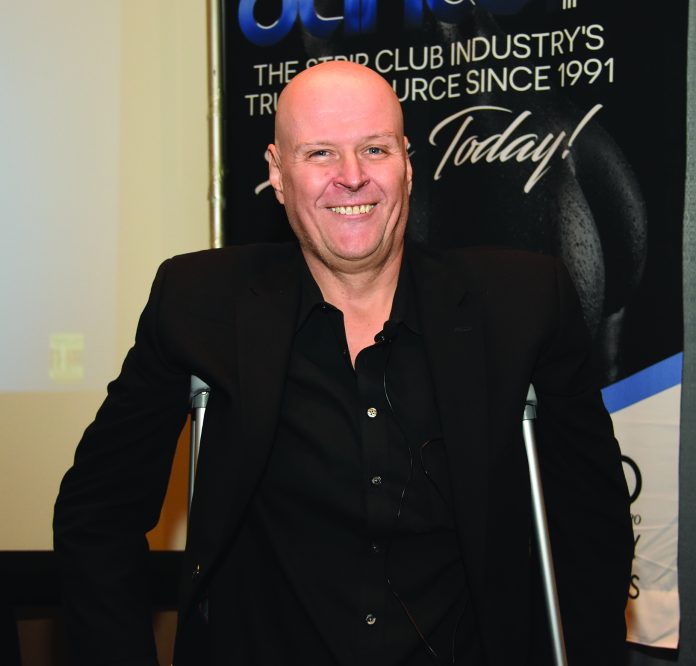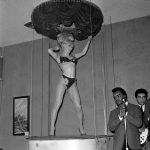(Note: This story appears in the September 2022 issue of ED Magazine)
Motivational speaker Willard Barth made a triumphant return to EXPO to offer a presentation on how owners and operators can properly hire and train their management and staff.
R
enowned motivational speaker Willard Barth made his return at EXPO 2022. Barth, who has spoken at six EXPOs previously, was on hand to discuss club management as part of the “Team Training & Motivation” Certification.
While guest experience and running a smooth operation trickles down from the top, a large part of a club’s success depends on a staff’s training and motivation. Barth provided attendees proven strategies to help your management train and motivate your staff to achieve optimal performance, improving customer experience and your bottom line.
Barth started with an anecdote involving an engineer who essentially saved FedEx one time when its massive conveyor belt system was down, costing the company $10,000 per minute with a quarter rotation of a screwdriver.
“I share that story not just to burn time, but there’s a lot of people in this room who have been in the industry for decades,” said Barth, author of the best-selling book “The Anatomy of Transformation.” “Some things I’m talking about today that you may already be doing, but the idea is that one-quarter rotation turn on something that you learned today can dramatically change your business. The most successful people that I know are always looking for that one idea that’s going to make things better.”
He pointed to former industry DJ of the Year Danny Meyers who is constantly striving to improve himself and the industry and find an edge.
“What I want to share with you today are things you may already be doing, but pay attention to the little shifts that can make a huge difference. Really, what training is how do I get my people to do better? How do I raise the standard — their execution of what I want them to do?”
He then implored the attendees to ask each other ‘What’s the biggest problem you have when it comes to either training or motivating your staff?’
Some examples included:
• Following directions
• Lack of leadership
• Lack of motivation
• Consistency
• Quality
• Inconsistent standards
“You think you invest time in training your employees, and then you look around at what’s going on and it’s like ‘That’s not what I taught them to do! What is going on?’” said Barth to a crowd agreed in unison. “One of the biggest challenges I find in these clubs is the continuity in training. You get one person, a leader, that trains a group of staff and they do it based on how they think it should be done, even though the owner may have said something different.”
Extrapolated over however many people have been tasked to train and it’s not hard to see there are conflicting — if not at the very least differing — training standards.
“By the time you come in as the owner or manager, nobody’s doing things consistently,” said Barth.
“One of the biggest challenges I find in these clubs is the continuity in training. You get one person, a leader, that trains a group of staff and they do it based on how they think it should be done, even though the owner may have said something different By the time you come in as the owner or manager, nobody’s doing things consistently.” — Willard Barth
To ensure that consistency in training, Barth encouraged attendees to document the training process, which he acknowledged can be difficult because owners/operators can become consumed with the day-to-day operations of the business.
A written-out SOP (standard operating procedures) can help a club run efficiently and effectively.
“There’s another fear that comes up with documenting procedures, and that’s opening yourselves to lawsuits,” said Barth, who added there is a need to differentiate between employees and independent contractors.
“When you’re documenting things for your employees, it actually can protect you because if something comes up or you’re accused of doing something incorrectly, your insurance carrier loves there’s documented training processes,” said Barth, who stressed he’s not an attorney and suggested running these procedures by your attorney.
He also recommended ID-ing your best employees and incorporating their practices into what is documented, using the example of a server who rings in 20% more than anyone else and finding out what it is specifically that enables them to succeed exceptionally.
“Documenting the process is extremely important,” said Barth. “This allows you to create an award-winning recipe for success.”
In addition to clearly outlining the steps, Barth explained how it’s important owners/operators/managers explain — and get employees to verbally articulate they understand — why said procedures are in place and how they stand to improve the club’s operations.
At this point, Barth identified a mistake he sees in many industries — not just the gentlemen’s club industry — which is taking a top salesperson/performer and anointing them a manager.
“You just killed your revenue that way, because selling and managing are two completely different beasts,” he said, noting people mistakenly expect proficient salespeople to translate to a proficient management. “You need to make sure whomever you’re delegating your training to is trained to train.”
Part of the training is a thorough explanation of the rules — demonstrating the process, training together, observe the person getting trained and then reviewing everything.
“This isn’t just a one-day training session,” said Barth. “You need to regularly monitor, read or review and stay on top of these things.”

According to Barth, the first time people are trained to do something, there’s a 15% competency rate (which leaves a lot of room for error). “You don’t get people operating at 80% competency until you’ve retrained them about five times. If you expect them to knock it out of the park after one training, you’ve hired a rock star; but most people aren’t capable of that. To maintain those standards, you have to measure, monitor, control and adjust, interspersed with regular reviews and feedback.”
He mentioned it can be incredibly helpful to present feedback in a positive way — not in an attacking or demeaning way. Referencing another author, Ken Blanchard that calls for the person providing feedback to be more responsive and less reactionary.
He provided a hypothetical example of how to give feedback in the training process.
“If you build them up first, they’re more receptive to the feedback you’re going to give them. If you say to somebody, I really appreciate the initiative that you took. Now, let’s talk about the action that went wrong; not ‘how could you be so stupid?’ There’s a lot of people, especially in this industry, who take criticism, pretty harshly. Let’s take a bit of that pressure off because we want them to take positive action, we want them to be motivated.”
In summing up his stance on proper training and accountability, Barth referenced another book “Extreme Ownership” (by Jocko Willink and Leif Babin).
“There’s a principle in the book that says if anything goes wrong with my team, I am responsible — not the person who made the mistake. I’m responsible because I didn’t teach them correctly. I didn’t work with them to help them be better. Rather than blaming people, it’s about taking responsibility for it. This is really where everything comes down to with training motivation. You’ve got to inspire people to be great.”
Barth closed out his seminar by talking about the sunk costs in failed training.
“People don’t think about what is it costing you not to have effective training motivation in place,” Barth said. “(Training) is not a glamorous part of the business in any way. But it is the part that will help you make a boatload of money.”
He spoke about a client he worked with, a company that was making $32 million a year. By going through and meticulously creating training processes for every facet of the company, the client increased revenue to $124 million in 18 months.
“I’m not saying this to impress you,” Barth said. “I’m saying it to drive the point home that you are losing a shit ton of money. Because you don’t have your processes documented, you’re not teaching people to follow the steps, you’re not going back and massaging that tissue to help them get better at it. When you do, the results that you’re going to get are going to be really amazing.”
For more information, visit willardbarthenterprises.com, email willard@willardbarthenterprises.com or call (201) 380-1131.


























